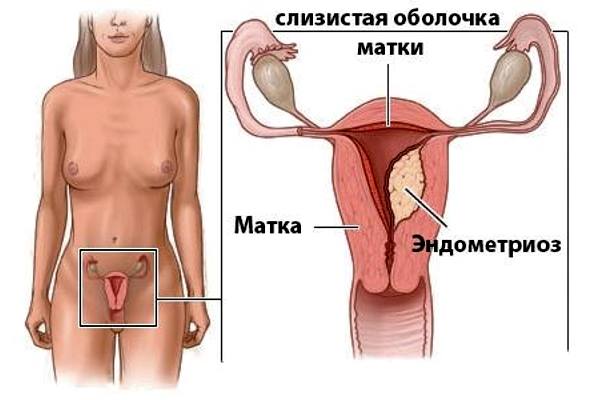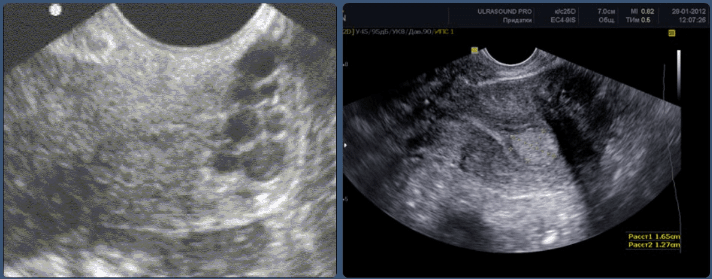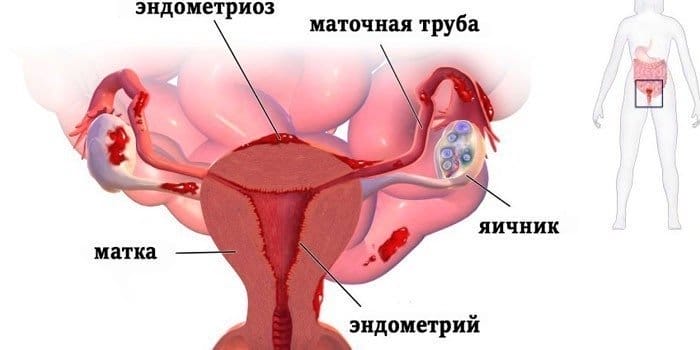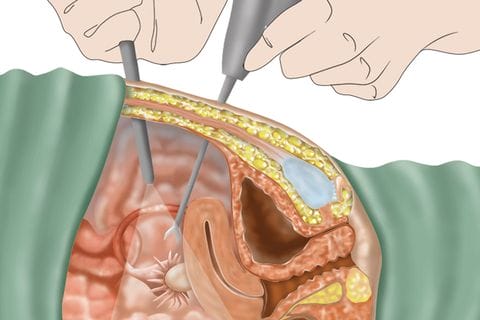Endometriosis of the uterus: what it is, how dangerous it is, symptoms, signs and treatment in an accessible language. How to recognize the symptoms of uterine endometriosis?
Definition of disease. Causes of the disease
Endometriosis– a chronic disease of the female reproductive system, characterized by the proliferation of tissue of the mucous membrane of the uterine cavity – the endometrium – beyond its limits. Endometriosis is manifested by chronic pain syndrome and infertility. Most often, endometrioid tissue, structurally somewhat different from the tissue of the normal endometrium, is located on the pelvic peritoneum, ovaries, fallopian tubes and uterine ligaments. Damage to adjacent organs may occur: colon, bladder, ureters. Also, endometrioid foci are found on the cervix, vagina and external genitalia. Endometriosis can penetrate beyond the reproductive system of a woman – into the lungs, kidneys, eye chamber, and can also be found in postoperative scars on the anterior abdominal wall and navel. Separately, endometriosis of the uterus is distinguished – adenomyosis.
The reasons for the development of endometriosis are still unknown. According to the first of the three existing theories, endometrial tissue during menstruation through the fallopian tubes enters the abdominal cavity and there is implanted on the peritoneum, which covers the internal organs.
The second theory suggests the transformation of the epithelium into endometrioid tissue, the third suggests that endometrial particles can enter various organs and tissues through the circulatory or lymphatic systems.
There is evidence of the role of heredity in the development of endometriosis; this disease is more common in women whose relatives also suffered from endometriosis.
Risk factors for developing endometriosis:
- A small number of births, late first births;
- Early onset of menstruation;
- Short period between periods, long period of menstruation;
- Low weight;
- Alcohol abuse;
- Abnormalities of the uterus that obstruct the flow of menstrual blood.
Endometriosis occurs only during the reproductive period of a woman; only a few cases of the disease are described before the onset of menstruation and after menopause. During pregnancy and the lactation period, the manifestations of endometriosis temporarily stop.
Endometriosis occurs in 5-6% of women in the general population and in over 50% of women with infertility.
To understand the physiology of the disease, it is necessary to define the concepts of “menstruation” and “endometrium”.
Endometrium – the inner layer of the uterine lining (from the Greek “endo” – inside, “meter” – the uterus). The endometrium is complexly structured. Its first layer is called basal, the second, which comes out with blood during the menstrual period, is functional.
In case of pregnancy, the fertilized egg is attached to the functional layer of the endometrium and rejection does not occur. The basal layer is the basis for the growth of the functional layer.
Menstruation in gynecology is the process of endometrial rejection under the influence of sex hormones, which normally occurs at intervals of one month. Menstrual flow is made up of endometrial cells mixed with blood.
In addition to the vagina, a small amount of menstrual flow enters the fallopian tubes, entering the peritoneal cavity, where it is destroyed by special protective cells.
But there are times when menstrual flow is not completely destroyed, and endometrial cells, once in the cavity of the pelvic organs, attach to the tissues of various organs and begin to grow, forming endometrioid tissue.
Endometrioid tissue differs from that of the endometrium that is located inside the surface of the uterus. Such fabric is more resilient. Once in other organs, it spreads and actively develops, independently going through phases similar to the endometrium: growth and menstruation, disrupting the proper functioning of the woman’s reproductive system.
Endometriosis can spread in the genital organs (on the ovaries, in the bladder, fallopian tubes), in the genital organs (genital) and outside (in the lungs, in the spinal cord and brain). This pathology is common especially among women before menopause.
According to the latest data, there is a trend towards the spread of the disease among young women and even adolescents. The disease has a negative moral impact on patients, worsens the quality of life, and causes pathologies of the reproductive system.
This disease is benign in nature, but if timely measures are not taken, it can turn into a malignant formation.
Therefore, timely diagnosis of the signs of the disease and treatment in the early stages, prevention of the chronic form are important. With endometriosis, a combination of severe pain in the pelvic organs and adhesions is possible. This is due to the arrest of nerve endings on the surface of internal organs.
Most often, the uterus, ovaries, rectum and bladder are affected by endometrioid tissue. Endometriosis of the cervix is not so common and, according to statistics, occurs less often than other forms.
Pathogenesis (what happens)
With endometriosis, nodes form in the uterus that resemble the inner lining of the uterus. Such nodes can be located both in the uterus and outside of it. This ailment is a benign tumor-like disease and manifests itself in women due to the atypical growth and further functioning of endometrial cells (this is the name of the inner mucous membrane of the uterus).
Tablets for endometriosis of the uterus
Minimal risks, high efficiency of drug therapy make this method the most popular in the treatment of endometriosis.
The action of the conservative method is aimed at performing the main tasks:
- suppress the production of certain hormones, including female estrogens;
- cause the extinction of ovulatory functions;
- eliminate heavy menstrual bleeding;
- eliminate clinical symptoms, especially pain syndrome
- stop endometriotic foci and tissue proliferation.
Drug treatment of pathology includes the following groups of drugs:
| Name | Description |
| AGNRH (gonadotropin-releasing hormone agonists) | The main function of the treatment is to induce hypoestrogen by stimulating artificial menopause. The cessation of menstruation stops the growth of tissue and leads to regression of the lesions. For example, a doctor’s appointment of Dipherelin, Zoladex or Buserelin. |
| Antigestagens | Suppression of the production of LH, progesterone, FSH leads to a slowdown in the proliferation of cells in the mucosal layer. Most often, Danazol or Mifepristone is prescribed for the drug treatment of endometriosis. The drugs have side effects. |
| Progestogens | In treatment, progesterone and its analogues contribute to the normalization of the menstrual cycle by lengthening the 2nd phase. Usually appoint Dyufaston, Utrozhestan, Norkolut. |
| COCs (oral contraceptives) | The combined funds interrupt ovulation, stabilize the hormonal background, stopping the development of pathology. For example, contraceptives Janine, Jess, Diane-35, Yarina, Klayra and others. |
Each of these groups of drugs has the property of suppressing the production of reproductive hormones in the drug treatment of endometriosis.
Visanne is registered
Other remedies are aimed at eliminating pain, complex symptoms, or preventing the recurrence of pathology. For treatment, NSAIDs (non-steroidal anti-inflammatory drugs) are used.
Byzantium
The drug is effective for the treatment of endometriosis of the uterus and ovary. It contains an active ingredient – micronized dienogest.
The action of the drug in the drug treatment of endometriosis:
- inhibits the production of female hormones;
- restores the lining of the uterus;
- interferes with nutrition of the lining, which leads to its atrophy.
Unlike analogues, the Vizanne drug during treatment does not contribute to the accumulation of fluid in the body and the development of hypertension.
Duphaston
Duphaston – an analogue of progesterone
A popular new generation product that has practically no side effects. It is analogous to natural progesterone.
Means of the progestogen group have similar properties of decidualization and atrophy of the endometrial layer. Duphaston with drug treatment of endometriosis effectively stops the development of pathology and pain syndrome.
Danazol
It is a synthetic androgen that simultaneously affects healthy and pathological areas of the endometrium. The medicinal effect of the drug ensures the cessation of menstruation, as a result of which atrophy of the mucosal layer occurs.
As a result of the absence of profuse bleeding during the drug treatment of endometriosis, the patient’s condition is noticeably improved, pain and other alarming symptoms disappear.
Buserelin
Buserelin is used for pain
Preparations of the AGNRH group affect the pituitary gland. They are used in the treatment of common endometriosis, severe symptoms, to relieve intense pain. And also as a preparatory therapy before surgery.
Buserelin and other agonists are rather aggressive drugs that cause artificial menopause. After discontinuation of the drug, the restoration of ovulation will last for more than a year.
However, when treating with Buserelin, almost 100% of patients, even in a serious condition, experience an instant disappearance of intense pain of any etiology.
After undergoing medical treatment for endometriosis, the effect lasts for 6 to 12 months. This is due to the prolonged action of the agent.
Classification and stages of development of endometriosis
There are the following forms of endometriosis:
- External genital endometriosis (endometriotic foci are located on the peritoneum of the small pelvis: tubes, ovaries, uterine ligaments);
- Endometrioid ovarian cyst (a type of external genital endometriosis);
- Retrocervical endometriosis (a type of external genital endometriosis) is an infiltrative variant in which the endometrioid tissue is located behind the uterus and can grow into the posterior vaginal fornix and intestine;
- Adenomyosis – endometriosis of the uterus;
- Extragenital endometriosis is a very rare form of endometriosis, in which foci of endometriosis are found in the lungs, kidneys, eye chamber, postoperative scars, navel, and on the skin of the perineum.
For external genital endometriosis, a surgical classification has been developed according to the prevalence of the pathological process in the small pelvis and the severity of the adhesive process. There are 4 stages from minimal damage to extremely pronounced.
Diagnosis of endometriosis
It is possible to suspect the presence of endometriosis by the patient’s complaints, that is, on the basis of asking about the nature and localization of pain and their connection with the menstrual cycle. During examination on the chair, points of local pain can be identified: with retrocervical endometriosis, painful “spines” are palpable in the posterior fornix of the vagina – a characteristic sign of this form of the disease. In the presence of adenomyosis, the uterus can be enlarged in size, have a characteristic spherical shape. Large endometrioid cysts will manifest themselves as an enlargement of the uterine appendages.
On examination of the cervix and external genitalia, characteristic “dark blue eyes” can be found, indicating the presence of endometriotic foci.
Ultrasound can detect adenomyosis and endometrioid ovarian cysts. Ultrasound diagnostics of these diseases, as a rule, does not cause difficulties, since there are specific echographic signs. External genital endometriosis cannot be detected by ultrasound, with the exception of infiltrative forms (retrocervical endometriosis), as well as skin localizations.
MRI capabilities are not often required, mainly to confirm the presence of uterine adenomyosis and to identify infiltrative forms of endometriosis.
There are no specific markers for the diagnosis of endometriosis. It is known that the CA125 tumor marker can be increased in endometriosis, especially in adenomyosis, but this marker is not specific, its increase is possible in many other pathological conditions, therefore it is not used for the diagnosis of endometriosis.
Typically, endometriosis is diagnosed using laparoscopy. The introduction of a special camera into the abdominal cavity allows you to see the foci of endometriosis under magnification and assess its prevalence. A biopsy is taken from the lesions to confirm the diagnosis, since visual confirmation is not always sufficient.
Hysteroscopy (examination of the uterine cavity using a miniature camera) reveals the presence of “endometrioid passages” in the walls, confirming the presence of adenomyosis, but this method is generally not very informative and necessary, since the presence of adenomyosis is easily detected by ultrasound, in addition, hysteroscopy does not allow to assess the prevalence of the pathological process, and ultrasound – allows.
Hysterosalpingography
This technique is important for detecting internal endometriosis (adenomyosis or endometriosis of the uterus). The study is carried out with a water-soluble contrast agent on the 5th, 6th or 7th day of the cycle. X-ray shows the presence of outline shadows.
Tomography
Computed tomography can provide information about the boundaries of the pathological process. Magnetic resonance imaging is more informative for endometriosis.
Ultrasound procedure
This technique allows you to characterize the pathology according to clear criteria. An ovarian cyst of endometrioid origin is characterized by the presence of a dense capsule, hyperechoic contents.
In the case of adenomyosis, the study can reveal areas with increased echogenicity, unevenness and jaggedness of the border areas of the endometrium and myometrium, inclusions of a round shape about 5 mm in diameter. Nodal variants of adenomyosis are accompanied by the formation of cavities with a liquid with a diameter of about 30 mm.
Hysteroscopy
This technique makes it possible to identify with high accuracy the endometrioid passages, the roughness of the relief of the walls of the uterus in the form of crypts or ridges. In 1997 V.G. Breusenko et al. Developed a hysteroscopic classification of the prevalence of the endometrioid process:
- The first stage: unchanged relief of the walls of the uterus, endometrioid passages are found in the form of blue “eyes” or bleeding foci. The wall of the uterus is characterized by unchanged density.
- The second stage: uneven relief of the uterine wall in the form of ridges or loose muscle tissue. Endometrioid passages are revealed. The uterine cavity does not stretch well. The wall has a higher density.
- The third stage: the inner surface of the uterus includes many bulges of various sizes that do not have clear boundaries. Sometimes endometrioid passages are noted on the upper part of the bulges. The uterine wall is very dense.
Differential diagnosis
Differential diagnosis is necessary to distinguish between endometrioid cysts and ovarian tumors. The final diagnosis is based on anamnesis and ultrasound. With ovarian endometriosis, there may be no pain, and with an oncological process, non-localized pain may appear.
In the oncological process and in endometriosis, an increase in the level of CA-125 is noted. Therefore, an increase in the concentration of this substance does not confirm only one diagnosis. In some cases, the final diagnosis is only possible during laparoscopic surgery.
In the case of rectovaginal localization of endometrioid foci, a differential diagnosis with metastases of chorionic carcinoma is required. For the final diagnosis, in this case, a correct history taking and a study of the hCG concentration is required (this also determines the signs of pregnancy).
A tubo-ovarian inflammatory process in the form of an abscess is difficult to diagnose due to the erased clinic of inflammation (for example, chlamydial etiology) and the complexity of distinguishing the process from a benign tumor or cyst of endometrioid origin.
If the formations on the ovary do not regress within two months, surgery is prescribed. Often the final diagnosis is made after surgery and biopsy examination.
Also, in the case of endometriosis, differential diagnosis with the hyperplastic process of the endometrium may be required. With the retrovaginal nature of the lesion and endometriosis of the ligamentous apparatus of the uterus, it is imperative to exclude malignant neoplasms in the organs of the digestive system.
The main types of surgery for endometriosis:
Laparoscopy is a minimally invasive access to the body through which ovarian cysts or other pathological foci of the disease are removed.
Laparotomy – a larger incision in the anterior abdominal wall for surgical intervention to remove foci of the disease from various internal organs.
Endometriosis symptoms
With endometriosis, a woman usually complains of very painful periods, regular pain in the lower abdomen, fatigue and weakness, headache, and sometimes nausea and vomiting. In this case, the patient often cannot become pregnant.
It is important to consider that the symptoms of endometriosis can be very different. Their manifestations directly depend on the individual characteristics of the patient’s body. Very rarely, this disease is generally asymptomatic, therefore, it can be diagnosed only if it undergoes a regular examination by a doctor. However, as a rule, certain symptoms of this disease still occur. Pain is considered the main symptom of endometriosis. In most patients, pain manifests itself in different forms. Another common symptom of the disease is dysmenorrhea. This symptom is most pronounced on the first or third day of menstruation. This symptom is associated with menstrual bleeding into the cyst.and, accordingly, an increase in pressure in the cyst. Also, dysmenorrhea can occur due to retrograde menstruation and irritation in the peritoneum. It can also manifest itself as a consequence of the active production of prostaglandins, which cause vasospasm and strong contractions in the uterus. Painful sensations on the days of menstruation are also manifested due to the touch of nearby organs with the endometrioid focus. In addition to the symptoms described, with endometriosis, a dark brown discharge may appear, which persists for several days after menstruation.
A certain number of women complain of pelvic pain, which is not related to the menstrual cycle. It occurs due to secondary inflammation in those organs that have been affected by endometriosis. Symptoms of endometriosis can also manifest as painful sensations during intercourse. Most often, a similar symptom occurs in women with endometriosis-affected vagina, rectovaginal septum, recto-uterine space. Also, there are back pains, menstruation is irregular, but they are especially abundant.
The second unpleasant symptom of this disease is the impossibility of conception. Infertility occurs in 25-40% of women who become ill. To date, all the causes of infertility in endometriosis have not been fully clarified. Obviously, there are changes in the fallopian tubes, ovaries, which provoked endometriosis, and pregnancy eventually does not occur. The second reason for the impossibility of conception in this disease is a malfunction of the immune system. Endometriosis can similarly affect the regularity of ovulation, and then pregnancy will not occur due to violations in the ovulation process that accompany this disease. Another symptom of endometriosis is menorrhagia.… However, this symptom of the disease is less common than the main symptoms.
The first signs of endometriosis
- Discomfort, recurrent pain during menstruation, which are localized outside the location of the uterus, with the exception of chest pain.
- Discomfort and pain during intercourse.
Secondary signs of the disease
- The presence of minor bleeding before and after menstruation, during intercourse – occurs with genital endometriosis (within the pelvic organs);
- Bloody discharge from the rectum, navel, mouth, nose and even eyes (bloody tear), which depends on the place where the pathologically overgrown area is located, in which cavity or in which tissues;
- The presence of blood particles in the patient’s urine (hematuria);
- Recurrent disorders in the gastrointestinal tract – bloating, constipation, intestinal obstruction;
- Development of dropsy (edema) of the kidneys, ureter;
- Chronic fatigue, loss of strength, nervous disorders, which may be caused by compression of nerve fibers;
- An increase in the lower abdomen, which is outwardly similar to 5-6 weeks of gestation. This is triggered by an increase in the size of the uterus.
The main types of surgical removal of foci of endometriosis:
Resection – complete removal of the pathologically enlarged focus of the disease. Many surgeons consider the most effective way to remove endometriosis with a subsequent lasting positive effect.
Electrocoagulation – the essence of the operation is to remove the pathological focus with a high-frequency electric current, in fact, this is a cauterization process, in which the tissue protein is destroyed, and the main tissue rejects the area damaged by the current.
Laser vaporization – by acting on the pathological focus of the laser, it is evaporated.
The consequences of endometriosis
More than 60% of women suffer from infertility, which has arisen against the background of developed endometriosis, as:
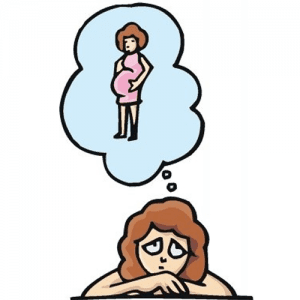 there is a violation of the monthly cycle due to hormonal changes;
there is a violation of the monthly cycle due to hormonal changes;- inflammatory processes in the abdominal organs lead to the formation of adhesions and deformation of the fallopian tubes, which complicates the fertilization of the egg;
- ovarian cystic formations interfere with the release of follicles and cause depletion of the ovarian reserve;
- foci of endometrioid tissue prevent the successful fixation of a fertilized egg inside the uterus. Pregnancy with endometriosis is hampered by hormonal disorders and often passes with complications for the mother and child;
- against the background of regular blood loss, women develop anemia and neurological disorders caused by damage to nerve fibers in the foci of the endometrium. Anemia caused by blood loss usually leads to dizziness and headaches, shortness of breath and general weakness;
- the most dangerous consequence of endometriosis can be the transition of endometrioid tissue to the state of a malignant tumor.
Medicines used in the therapy of pathology
The gynecologist selects the medicine for endometriosis based on the severity of the disease. The drugs used are used:
- to reduce the production of sex hormones;
- from uterine bleeding;
- to eliminate pain symptoms and other negative manifestations;
- before surgery;
- during the rehabilitation period, after surgery.
Medicines for endometriosis should be taken only according to the scheme prescribed by the doctor. You should strictly adhere to the recommended course duration, since many drugs, with longer use, can cause many side effects.
What medications can be used to treat endometriosis? This question is often asked by women who have discovered this pathology in themselves. As a rule, drugs of several groups are used in the treatment of this disease, these are:
- Gonadotropin-releasing hormone agonists. Medicines are hormonal. Reduces the amount of estrogen production. They can be used both in tablet form and in the form of injections. They bring the body into artificial menopause. Menses stop coming due to lack of estrogen. Against this background, the endometrium also stops growing. The lesions are regressing. Such drugs should be treated for about six months. Longer therapy can lead the body to early menopause. The best drugs for endometriosis in this group are the drugs Zoladex, Differelin, Buserelin.
- Antigestagens, inhibitors of gonadotropic hormone production. Drugs in this category inhibit the production of luteinizing, follicle-stimulating hormones. Suppress the production of progesterone. The drugs are available in the form of tablets and capsules. Medicines have pronounced side effects. The most popular medicines are Mifepristone and Danazol.
- Gestagens. Another group of medicines used in the treatment of endometriosis. Progesterone pills stabilize the menstrual cycle by lengthening the second phase. The most effective drugs in this category include “Norkolut”, “Dyufaston”, “Utrozhestan”. Medicines can be prescribed not only in the form of tablets, but also in the form of injections.
- Combined oral contraceptives. They contain estrogens and gestagens. Stimulates the production of female sex hormones. Stabilize the development and prevent the growth of the endometrium. Drugs in this category are drunk for about six months. Popular: “Janine”, “Klayra”, “Diane-35”, “Jess” and “Yarina”.
Intrauterine devices can be used to treat the disease. The most popular is Mirena. Sometimes medications containing male hormones, androgens are used. One of these drugs is “Methyltestosterone”. In addition to these drugs, non-hormonal drugs can also be used in the treatment of endometriosis.
Treatment of endometriosis is complex and long-term, at least six months. To achieve a good result, you must follow all the doctor’s instructions. Do not violate the treatment regimen. The disease is very serious and can progress, so self-medication in this situation should be ruled out.
Possible complications of endometriosis
Common complications:
- the formation of scars and adhesions;
- inflammatory processes in the small pelvis;
- peritonitis;
- depletion of the ovaries and cessation of ovulation;
- the development of infertility;
- pathology of pregnancy;
- complications during childbirth;
- malignant degeneration of pathological tissues;
- increased risk of ovarian cancer.
The inability to conceive is a serious consequence of endometriosis. It is not great in the early stages of the disease, and increases significantly with the degree of its progression. This is due to the fact that overgrown endometrial tissue can block the fallopian tubes, which interferes with the fertilization of a mature egg. Therefore, with endometriosis, it is impossible to postpone the planned pregnancy “for later”.
Combined oral contraceptives
Low-dose oral contraceptives are widely used in the treatment of endometriosis in young women. They minimize exposure to male hormones. At the time of taking the pills, the greasiness of the skin and hair decreases in women, the amount of acne is noticeably reduced. This therapy is often carried out in conjunction with surgery. If the operation is not done, then the medicine for endometriosis of the uterus is drunk for 6-9 months.
The following medicines are considered the most effective:
- “Silhouette”. These are hormonal pills of the combined type. They have antiandrogenic and anti-inflammatory properties. The active ingredient is ethinyl estradiol. The medicine “Silhouette” for endometriosis is taken daily, one tablet a day. A therapeutic course of at least three weeks. The cost of the drug is about 700 rubles.
- “Norkolut”. The drug is very quickly absorbed into the gastrointestinal tract. Works two hours after ingestion. Contains an active ingredient – norethisterone. The drug is taken from the fifth to the fifteenth day of the menstrual cycle. The daily allowance is 5 ml. The duration of the course is six months. The price is 350 rubles.
- “Yarina”. The medicine has antiandrogenic properties. Reduces the activity of the sebaceous glands. Reduces acne. The medicine for endometriosis is drunk every day for three weeks. The duration of admission is regulated by the doctor. The drug costs about 500 rubles.
- “Regulon”. It is a contraceptive multiphase drug. Contains two active ingredients, ethinyl estradiol and desogestrel. The pills activate the secretion of sex hormones. They are drunk daily. The course is 21 days. The price of the medicine is about 300 rubles.
- “Claira”. Combined contraceptive drug. Its action is based on the properties of two active ingredients: dienogest and estradiol valerate. The medicine changes the quality of the cervical fluid, which suppresses the ovulation process. The course is 28 days. The drug costs about one thousand rubles.
- Novaring. The drug is presented in the form of a special ring for the vagina. Contains two active ingredients – etonogestrel and ethinyl estradiol. The medication is injected into the vagina on day 21. Price 380 rubles.
- Jess. It is characterized by antiandrogenic properties. Active ingredients: drospirenone and ethinylestradiol. It is taken orally. The duration of treatment is 28 days. Tablets cost around 1000 rubles.
- Novinet. Suppresses ovulation. Stabilizes the quality of cervical mucus. Contains ethinyl estradiol with desogestrel. The medicine is taken for three weeks, then a 7-day break is taken. After that, the course of treatment is continued. The price is 600 rubles.
- “Logest”. It contains ethinyl estradiol in combination with gestodene. Suppresses ovulation processes. Normalizes the state of cervical mucus. The tablets are taken orally for 21 days. Then they take a break for a week. If necessary, the treatment is continued.
These drugs should be taken at the same time. If the drug is prescribed without a seven-day break, then menstruation does not come.
Pathomorphology
Endometriotic lesions can vary in size and shape: from rounded formations a few millimeters in size to shapeless growths a few centimeters in diameter. They are usually dark cherry in color and are separated from the surrounding tissues by connective tissue whitish scars. The foci of endometriosis become more noticeable on the eve of menstruation due to their cyclical maturation. Spreading to the internal organs and peritoneum, areas of endometriosis can grow deep into the tissue or be located superficially.
Ovarian endometriosis is expressed in the appearance of cystic growths with dark red content. Heterotopies are usually arranged in groups. The degree of endometriosis is assessed in points, taking into account the diameter, depth of germination and localization of foci. Endometriosis is often the cause of adhesions in the small pelvis, limiting the mobility of the ovaries, fallopian tubes and uterus, leading to irregularities in the menstrual cycle and infertility.
Pregnancy with endometriosis
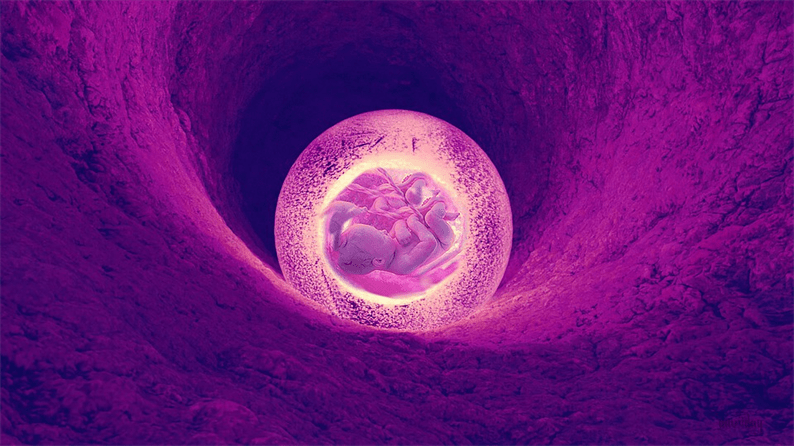 Pregnancy with endometriosis is possible, it should take place under the constant supervision of a doctor. In the first three months, there is a high probability of miscarriage, so the doctor prescribes hormonal drugs to maintain the pregnancy.
Pregnancy with endometriosis is possible, it should take place under the constant supervision of a doctor. In the first three months, there is a high probability of miscarriage, so the doctor prescribes hormonal drugs to maintain the pregnancy.
The risk of miscarriage decreases after the formation of a placenta not affected by endometriosis, which is capable of forming hormones on its own. After childbirth, as a rule, the disease returns again, so it is necessary to continue treatment again.
Contraindications to the use of hormones
Although hormone therapy is considered in modern gynecology the most effective method of treating endometriosis, not always and not all women can use this type of treatment.
Contraindications to the hormonal method may be conditions:
- Allergic reactions to the drugs used.
- The presence of concomitant diagnoses (fibroids, ovarian cysts) requiring surgical treatment.
- Pre-existing thrombosis or thromboembolism due to diseases of the blood system or heart.
- Pathologies of the cervix (dysplasia, precancerous diseases).
- Serious kidney or liver disease (hepatitis, cirrhosis).
- Pathologies of the hematopoietic or endocrine systems.
- Hypertension of a malignant course.
- Malignant pathology in the body.
In case of contraindications to hormonal treatment, non-hormonal therapy is selected.
Surgical treatment of endometriosis
Depending on the course of the disease, the following types of operations are performed:
- Hysteroscopy – a special device for minimally invasive surgery is used. It is designed for intrauterine surgery. Penetrates inside through the cervix and removes foci of pathological growth
- Electrocoagulation is used to eliminate accessible small foci.
- Laser vaporization – laser burning out foci of growth.
- Laparoscopy – an optical device (laparoscope) and a special small-sized manipulator are inserted through a small puncture. Healing after laparoscope punctures is faster than after cavity incisions.
- Abdominal surgery – is used in the case of the prevalence and multiplicity of foci, and the impossibility of using less invasive methods.
If fertility is impaired, hormonal therapy is performed, and the patency of the fallopian tubes is surgically restored. If a woman is over 40 and does not plan to become pregnant, surgical excision of the affected part of the genital organs is recommended.
Complications of endometriosis
The most frequent and significant complication of endometriosis is infertility, which occurs on average in 50% of patients with this disease. Two factors can lead to infertility. Firstly, as a result of the formation of adhesions, damage to the fallopian tubes is possible, impairing their patency. The second mechanism that prevents conception may be developing disorders in the immune system of the abdominal cavity, which leads to damage to the sperm and ovum. These mechanisms are not fully understood. It is important to remember that half of patients with endometriosis, despite the presence of this disease, become pregnant without any treatment.
A complication of adenomyosis is iron deficiency anemia, which develops as a result of heavy menstrual blood loss. Whether adenomyosis affects the possibility of pregnancy is not fully known. Reproductive experts note that the presence of adenomyosis can reduce the chances of pregnancy in IVF cycles.
Infiltrative forms of endometriosis can damage the intestines and ureters, leading to dysfunction of these organs.
Progestogens
What medications are prescribed for endometriosis? In the treatment of this disease, a variety of drugs can be used, including gestagens. These drugs are substitutes for progesterone, a female hormone that is produced by the corpus luteum of the ovary. This substance is synthesized at the site of the ruptured follicle, after the ovulation process. It has a positive effect on hormones and improves the structure of the endometrium.
The best drugs for endometriosis in this group include the following drugs:
- “Duphaston”. The drug is prescribed to drink from 5 to 25 days of the menstrual cycle. Then they take a week break and resume taking the drug. The daily dose is 10-20 mg.
- Norethisterone. The treatment regimen is similar to that of Dufaston. The maximum permissible daily rate is 5 mg.
- Mirena. Intrauterine device. The active ingredient is levonorgestrel.
- “Utrozhestan”. The drug is prescribed from 16 to 25 days of the menstrual cycle. The treatment course can last up to 9 months. Judging by the reviews, it helps to cope with pathology.
The medicine for endometriosis “Visanne” deserves special attention. It is used most often. The drug has shown just an excellent result in the treatment of this disease. The medication is drunk one tablet a day, for about a year.
The drug reduces lesions and reduces the number of vessels that provoke the appearance of endometriosis, which significantly reduces the trophism of the disease. Side effects when taking Visanne are rare. As a rule, this is a disorder of the gastrointestinal tract, pain in the abdomen, headache, skin rashes and depression.
Medicines for fibroids and endometriosis are the same. With the nodular form of fibroids, gynecologists usually prescribe “Duphaston”. “Vizanne” is prescribed at an advanced stage of the development of the disease.
Laparoscopic operations
Currently, endometriosis is treated with endoscopic surgery, which has a minimum of complications and minimizes tissue trauma. Laparoscopy is most effective in infertility with the presence of “small” forms of endometriosis.
At the same time, endometriotic foci are removed, eliminating the risk of their re-spread. Almost 95% of all interventions for adenomyosis are performed laparoscopically. At the time of such an operation, ultrasound or laser irradiation is usually used to remove the detected lesions. After electrocautery, hormone therapy is usually also used.
Postoperative therapy (at the discretion of the treating physician) usually includes hormone therapy to prevent recurrence within 6 months.
Antigonadotropic drugs
As a rule, if the disease is not started, then medications are prescribed to treat it that stop the production of pituitary hormones. After all, it is they who actively stimulate the work of the ovaries. They inhibit the synthesis of LH and FSH.
When using these drugs, the patient has an artificial menopause and the production of estrogen is reduced to a minimum level.
The best medicines in this group include:
- Buserelin. Available as a spray. It is applied for about 4-6 months. Three instillations are injected daily into each nasal passage.
- Buserelin Depot. Available in ampoules. It is used as an injection. The drug is administered once a month, intramuscularly.
- Zoladex. The medicine is produced in the form of subcutaneous capsules. It is injected under the skin every 28 days.
- Danazol. Produced in capsules for oral administration. Refers to antigonadotropins. It is characterized by a slight anabolic effect. Slows down the growth of the endometrium. Prevents the onset of ovulation. Blocks the synthesis of sex hormones. The daily dose is 400 mg. Judging by the reviews, this is a fairly effective drug.
This group of drugs is prescribed before and after surgery to prevent the growth of foci. The drugs are difficult to tolerate by patients and can cause a number of negative effects. The duration of their admission is 6-9 months.
Reconstructive physiotherapy
Rehabilitation therapy is prescribed both after hormonal and after surgical treatment. This is necessary to correct complications after prolonged use of hormones and to prevent the appearance of adhesions.
Physiotherapy is prescribed only if there are no contraindications for this type of recovery. Do not underestimate this type of treatment as it is forward-looking and capable of:
- have an analgesic and anti-inflammatory effect;
- restore the hormonal background of the ovaries;
- dissolve existing adhesions and prevent the emergence of new ones;
- prevent possible infertility.
As physiotherapy for adenomyosis, methods and schemes are used that are selected by a physiotherapist for a particular woman. In this case, magnetotherapy, electrophoresis can be used (options with lidase, magnesia, a combination of zinc with iodine, etc. are possible), laser therapy.
Balneotherapy in sanatoriums is effective for endometriosis.
Treatment methods are used with particular efficiency in sanatoriums in the form of:
- rhodon and iodine-bromine baths;
- intestinal microclysters;
- vaginal irrigation.
Spa treatment is considered to be very beneficial for patients with endometriosis. With a correctly prescribed course, this type of treatment has a complex positive effect on the body in the form of:
- reduction of foci of endometriosis;
- increasing immunity;
- correction of psycho-emotional disorders;
- reducing allergic reactions;
Spiral “Mirena”
The therapeutic system inhibits the growth of the endometrium. Contains levonorgestrel, a substance that is analogous to the female hormone progesterone.
The spiral acts on the woman’s body locally, as a result of which less hormones enter the body than when using tableted drugs.
“Mirena” normalizes the menstrual cycle, reduces the duration of menstruation and the amount of bleeding. Relieves pain.
Mild endometriosis can be easily treated with this medication. At the beginning of the use of the spiral, spotting may be observed. But, after some time, the situation changes dramatically. The cycle is leveled. And your periods become shorter and less abundant. For some women, after the installation of the spiral, menstruation stops altogether. With endometriosis, this is a positive development.
Endometriosis medicine, non-hormonal
In addition to hormonal drugs, non-hormonal drugs can also be used in the treatment of endometriosis, these are:
- Immunomodulators. Such as: “Levamisole”, “Polyoxidonium”, “T-activin”, “Likopid”, drugs with interferon and others.
- Non-steroidal anti-inflammatory drugs. They relieve inflammation and relieve pain. The most effective are Diclofenac, Naproxen, Ibuprofen, Indomethacin. They are used five days before the onset of menstruation.
- Natural herbal remedies. These drugs for ovarian endometriosis cause fewer side effects than hormonal drugs, but they are less effective. It takes much longer to achieve the desired effect. Despite their naturalness, it is not worth using them without a doctor’s prescription. Most often, for endometriosis used “Cyclodinone” and “Gynekol”.
- Dietary supplements. These drugs do not cure endometriosis and have not passed all the necessary clinical trials, but their use can improve the result. The most common are Indol Forte and Ovariamin.
Antibiotics may be prescribed to treat endometriosis if indicated. But these medicines are rarely used, as they stimulate the development of the disease and provoke the growth of the endometrium.
Prognosis for adenomyosis
Endometriosis is considered an insidious and recurrent disease. And a similar tendency is stable as long as the woman has her period (before menopause).
Often, over the years, the risk of recurrence of the disease increases. If a year after treatment the risk of recurrence of adenomyosis is about 10-20%, then after 5 years this statistics increases to 50% and even up to 70% of the risk of disease recurrence. The risk of recurrence is especially high in severe forms of endometriosis.
The prognosis of the disease is associated with factors such as:
- age;
- localization of foci and severity;
- the need for childbirth.
In terms of “prospects” for the further development of endometriosis, it is known about:
- Possibilities of self-healing from an illness. This is possible in conditions associated with a change in the hormonal balance of a woman (pregnancy, lactation, menopause).
- The chances of getting pregnant are 40-70% with this disease, depending on its severity. With a slight degree of endometriosis, it is often possible to become pregnant without any treatment.
- Using pregnancy as the best way to cure endometriosis. At the same time, pregnancy and lactation not only temporarily eliminate the manifestations of the disease, but enable some patients to completely get rid of the pathology.
- Carrying out radical operations as the best way to get rid of endometriosis with the most favorable prognosis. This method is suitable for women who no longer wish to have children. After that, the disease does not return.
- The use of hormone therapy during the premenopausal period as the most effective conservative way to get rid of endometriosis.
- Using “minimally invasive” surgeries to restore fertility. Although relapses after this are not canceled (up to 40% of cases after 5 years). Reoperation is sometimes necessary after relapses.
The criterion for getting rid of endometriosis is the absence of relapses within 5 years after cure, with the complete disappearance of symptoms and the woman’s general well-being.
Prophylaxis
It is impossible to indicate clear measures for the prevention of endometriosis, since this ailment and its exact causes are still poorly understood.
However, a woman can exclude most of the factors that serve as the impetus for the appearance of this ailment. To do this, it is enough to follow your own lifestyle, maintain immunity, cope with stress, prevent artificial termination of pregnancy and promptly treat any pathology of the female genital area.
Common questions about endometriosis
The most common questions asked by women diagnosed with endometriosis are:
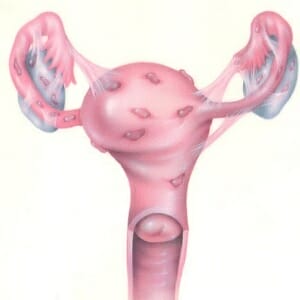 Is it okay to have sex? Yes, sex is not forbidden, and sometimes even helps to relieve symptoms.
Is it okay to have sex? Yes, sex is not forbidden, and sometimes even helps to relieve symptoms.- Do I need to follow a specific diet and lifestyle? Proper nutrition and moderate exercise will help support the body and give it strength in the fight against the identified disease.
- Can endometriosis develop into uterine cancer? A benign course of the disease can turn into a malignant one only in an extreme, advanced form.
- At what age does adenomyosis occur? The disease can develop both in immature girls and in women of reproductive and climacteric age.
- What is the impact of pregnancy on the course of adenomyosis? The development of endometriosis can lead to infertility. If a woman, against the background of the disease, still manages to become pregnant, the disease subsides. This is due to a decrease in estrogen levels and an increase in progesterone in a woman’s body. The disease usually returns after a period of childbirth and breastfeeding.
- Is endometriosis a hereditary disease? In medical practice, many cases of endometriosis are caused by heredity. The literature describes the forms of inheritance of the disease and the gene that causes this pathology. If, nevertheless, the symptoms of endometriosis were detected, you should immediately consult a doctor, and not look for methods of treatment on the Internet yourself.
Output
From this it follows that it is necessary to visit the gynecologist more often, to undergo the necessary gynecological examinations (ultrasound of the small pelvis 1-2 times a year). To avoid the appearance of this unpleasant ailment, you need to eat correctly and in a balanced way, refuse to take alcoholic beverages and smoke tobacco, and seafood and fresh sea fish should be present in the diet.
Sources used and useful links on the topic: https://ProBolezny.ru/endometrioz/ https://medside.ru/endometrioz https://sberemennost.ru/planirovanie/kak-lechit-endometrioz-matki https: // tvojajbolit. ru / ginekologiya / endometrioz-matki-chto-eto-takoe-chem-on-opasen-simptomyi-priznaki-i-lechenie-dostupnyim-yazyikom / https://medicina.dobro-est.com/endometrioz-simptomyi-i- lechenie.html https://woman-centre.com/endometrioz/yendometrioz.html https://FB.ru/article/406355/samyie-luchshie-lekarstva-ot-endometrioza https://www.polyclin.ru/articles / endometrioz / https://www.KrasotaiMedicina.ru/diseases/zabolevanija_gynaecology/endometriosis https://BornInVitro.ru/zhenskoe-besplodie/lechenie-endometrioza/ https://endometrioz.su/chto-takoe-endometrioz-vidy-prichiny-i-diagnostika/

